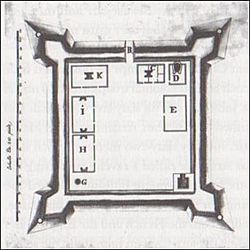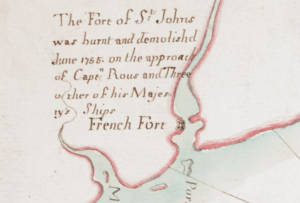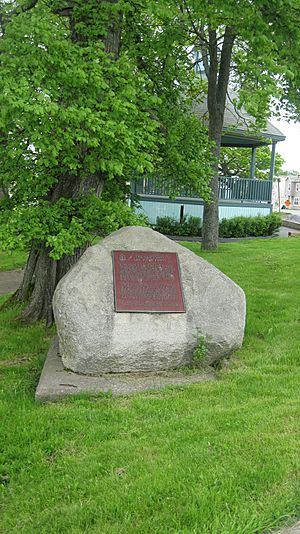Fort Menagoueche facts for kids
Quick facts for kids Fort Menagoueche |
|
|---|---|
| Saint John, New Brunswick, |
|
 |
|
| Coordinates | 45°15′52″N 66°04′25″W / 45.2644°N 66.0736°W |
| Type | Historical French Fort |
| Official name: Fort Charnisay National Historic Site of Canada | |
| Designated: | 1923 |
| Site information | |
| Owner | |
| Controlled by | 1751-1755: 1758-?: ?-present: |
| Site history | |
| Built | 1751 |
| Built by | Charles Deschamps de Boishébert et de Raffetot Ignace-Philippe Aubert de Gaspé |
| In use | 1751-1755: 1758-?: ?-present: |
Fort Menagoueche (also known as Fort Menagouèche in French) was a French fort built in 1751. It was located at the mouth of the St. John River in New Brunswick, Canada. French officers Charles Deschamps de Boishébert et de Raffetot and Ignace-Philippe Aubert de Gaspé oversaw its construction.
The fort was built during a time of conflict called Father Le Loutre's War. This war was fought between the French and their allies (Acadians and Mi'kmaq) and the British. The French later burned Fort Menagoueche themselves in 1755. This happened when they had to retreat after losing the Battle of Fort Beauséjour. The British later rebuilt a fort on the same spot, calling it Fort Frederick.
Because this location was so important for both French and British forts over time, it was named a National Historic Site of Canada in 1923. This means it's a special place that helps tell Canada's history.
Why Fort Menagoueche Was Built
In 1710, the British took control of a region called Acadia (which is now part of Nova Scotia). However, many Catholic Acadians and Mi'kmaq people still lived there.
A new conflict, Father Le Loutre's War, started in 1749. This happened when the British began building new settlements like Halifax. Some Mi'kmaq people felt the British were breaking earlier peace agreements. To protect their new towns from attacks by the Mi'kmaq, Acadians, and French, the British built several forts. These forts were in places like Halifax (1749), Dartmouth (1750), and Bedford (1751).
The British also built forts in major Acadian communities. These included Windsor (Fort Edward), Grand-Pré (Fort Vieux Logis), and Chignecto (Fort Lawrence). A British fort already existed at Annapolis Royal.
The French knew that the British presence was a threat. They realized that the St. John River area was a key route. It was the only land path between their important fort at Louisbourg and Quebec City. If the British controlled this route, they could attack Quebec.
To protect this important path, the French decided to build three forts. These were built within 18 months starting in 1749. One was at Baie Verte (Fort Gaspareaux), one at Chignecto (Fort Beausejour), and the third was Fort Menagoueche at the mouth of the St. John River.
Building Fort Menagoueche
Acadians had lived in the St. John River valley for a long time. After the British took Acadia in 1710, more Acadians moved to the French-controlled Saint John River area. These Acadians were known for strongly resisting British rule.
The local Maliseet people also had a strong militia. They fought alongside the Mi'kmaq against New England forces during earlier wars.
In 1748, the French built a fort at the mouth of the St. John River. Later that year, Acadians and Mi'kmaq stopped a British officer, John Gorham, from landing there. He wanted them to swear loyalty to the British, but his soldiers were shot at.
In 1749, at the start of Father Le Loutre's War, the French officer Boishebert challenged a British naval officer at St. John. Boishebert first built a fort called Fort Boishebert. He later moved further down the river to build Fort Menagoueche.
Fort Menagoueche was built in 1751. It was ordered by the Marquis de la Jonquière, a French governor. It was mainly a fortified warehouse and a way station. This means it was a safe place to store supplies and for travelers to rest. It connected Fort Beauséjour with Louisbourg and Québec. It had a small group of soldiers to guard it.
The Fort's Final Days
In April 1755, a British ship found a French schooner (a type of boat) carrying war supplies. These supplies were meant for Boishebert at Fort Menagoueche. The British then tried to stop any ships from reaching the fort.
A road was built in 1754 to connect Fort Menagoueche with Fort Beauséjour. This made it easier to send messages and supplies between the two forts.
Soon after the Battle of Fort Beauséjour in 1755, the British sent soldiers to take Fort Menagoueche. Boishebert knew his forces were much smaller than the British. So, he decided to burn the fort himself. This way, the British couldn't use it. He then retreated up the river to continue fighting using guerrilla tactics.
With Fort Menagoueche destroyed, Louisbourg was the last major French fort in Acadia. The British later rebuilt a fort at the St. John River site. They named it Fort Frederick during their campaign in 1758.





